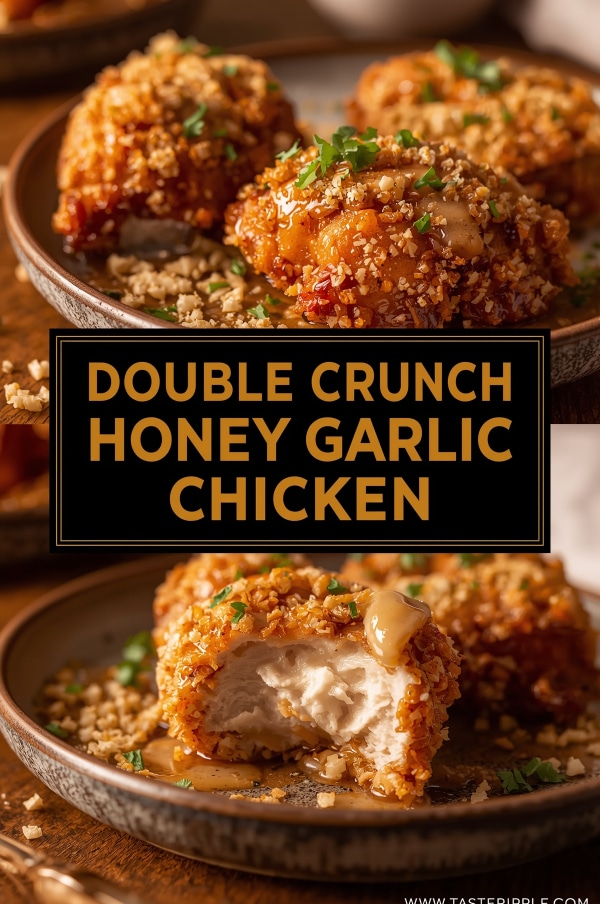I still remember the first time I pulled a skillet of Double Crunch Honey Garlic Chicken off the stove. The sound of the crust, snapping like dry leaves under foot, still rings in my ear. And that sauce—sticky, glossy, golden brown—clinging to each ridge of the fried crust like it knew it had found its home. If a dish could make a person grin like a fool, this one did it for me.
This recipe is not ordinary fried chicken. It is fried chicken reimagined. Think of chicken cutlets, but with armor. The crust is built in layers—flour, egg, flour again—like a shield that doesn’t just protect the meat but enhances it, holding in juices while turning the outside into a crunchy symphony. The honey garlic glaze is where the melody shifts—sweet, tangy, with the faint burn of garlic. When the two meet, you don’t just eat chicken, you experience contrast, a sort of culinary duel between crunch and stick, savory and sweet, sharp and mellow.
What makes this dish special? It’s the double-dredge technique, the deliberate crunch building. It’s the balance of texture and taste. And, maybe more than that, it’s the versatility. You can serve it with rice, noodles, inside a sandwich, or even chopped up on a salad. Wherever it goes, it steals the show.
Ingredients and Substitutions
One of the secrets of professional cooking lies not just in knowing what ingredients go in, but why they matter. Chicken breasts, for instance, give you lean, uniform cutlets. But thighs, while trickier to handle, bring juicier, darker meat. Fresh garlic blooms differently than powder—it caramelizes in the honey, adding depth you simply won’t get from granules. Even flour matters. All-purpose will get you there, but a touch of cornstarch makes the crust lighter, more shattery.
Here’s the ingredient breakdown for a standard batch that feeds 4.
| Ingredient | Measurement | Substitution / Notes |
|---|---|---|
| Boneless chicken breasts | 4 pieces (about 2 lbs) | Thighs for more juiciness, tofu for vegetarian version |
| All-purpose flour | 1 ½ cups | Mix with 2 tbsp cornstarch for extra crispness |
| Eggs | 3 large | Buttermilk (¾ cup) as alternative binder |
| Garlic powder | 2 tsp | Fresh minced garlic in flour mix, but may burn slightly |
| Paprika | 2 tsp | Smoked paprika for deeper flavor |
| Salt | 2 tsp | Sea salt for more minerality |
| Black pepper | 1 tsp | White pepper for subtler heat |
| Onion powder | 1 tsp | Can skip, but it rounds out flavor |
| Baking powder | ½ tsp | Helps lighten the crust slightly |
| Honey | ½ cup | Maple syrup for a different sweetness |
| Soy sauce | 3 tbsp | Tamari for gluten-free |
| Fresh garlic | 5–6 cloves, minced | Roasted garlic for mellower taste |
| Olive oil | 2 tbsp | Butter if you want richer glaze |
| Water | ¼ cup | Chicken stock for more depth |
Notice how the crust seasoning carries both garlic and onion powder—two subtle layers that make the chicken savory enough before the glaze even touches it. If you skip them, the final dish risks being flat.
Step-by-Step Instructions
This is where the craft takes shape. If you rush, you’ll lose crispness. If you linger too long, the glaze might caramelize into bitterness. Timing is everything.
Step 1: Prepare the Chicken
Slice the chicken breasts in half horizontally to create thinner cutlets. This ensures even frying. Pound them lightly with a meat mallet, but don’t flatten them like schnitzel—just enough to even the thickness. Uneven thickness means uneven cooking, which gives you dry tips and raw middles.
Step 2: Season the Flour
In a wide shallow bowl, whisk together flour, garlic powder, onion powder, paprika, salt, pepper, and baking powder. Baking powder is the quiet hero—it introduces air into the crust, making it lighter and crunchier. Don’t skip it unless you absolutely must.
Step 3: Prepare the Egg Wash
In another bowl, beat the eggs until smooth. Some chefs add a splash of water or milk here, but I prefer them as-is—the proteins in eggs bind flour more firmly, building that double crunch we’re after.
Step 4: Dredge the Chicken (Double Coat)
Dip each piece of chicken into the flour mix, pressing to make sure it sticks. Then dunk it into the egg wash. Finally, back into the flour mix again. Press firmly this time—don’t just shake it around. Pressing embeds the flour into the egg layer, forming ridges and layers that will later fry into crisp peaks.
Expert tip: Let the dredged chicken rest on a wire rack for 10–15 minutes before frying. This gives the coating time to hydrate slightly and adhere. Fry too soon and the crust risks flaking off.
Step 5: Fry the Chicken
Heat oil in a heavy skillet or Dutch oven to 350°F (175°C). You want about ½ inch depth—not deep frying, but shallow enough to manage. Lay the chicken in gently, don’t crowd, and fry 4–5 minutes per side until golden brown and cooked through (internal temp 165°F). Resist the urge to flip too often—every flip weakens the crust.
Mistake to avoid: frying at too low temperature. Oil below 325°F soaks into the crust, making it greasy. Always use a thermometer if possible.
Step 6: Make the Honey Garlic Sauce
In a small saucepan, heat olive oil. Add minced garlic and sauté gently until fragrant—don’t let it burn or the sauce turns acrid. Add soy sauce, honey, and water. Simmer for 2–3 minutes until slightly thickened. It should coat the back of a spoon, not pour like water.
Variation: Add chili flakes for heat, or a teaspoon of Dijon mustard for tang.
Step 7: Combine Chicken and Sauce
Place the fried chicken on a wire rack or parchment. Drizzle the sauce generously, or toss the chicken in a bowl with sauce if you want every inch coated. I prefer drizzling—it keeps the crunch alive while letting the sauce pool in nooks and crannies.
Cooking Techniques and Science
Why does double dredging work so well? It’s about layering starch and protein. The first flour coat dries the surface and roughs it up. The egg wash binds to that, introducing proteins that firm under heat. The second flour coat sticks to the egg, building tiny ridges that harden and puff when fried. That’s why the crust doesn’t just crunch, it shatters.
The frying technique matters too. Shallow frying in moderate oil ensures the chicken cooks through without scorching the crust. High heat burns honey-based sauces, which is why you always glaze after frying.
Let’s not forget the glaze chemistry. Honey is hygroscopic—it draws in moisture from the air, which helps the sauce stay sticky on the crust rather than hardening. Garlic, when sautéed, releases allicin that mellows into sweet, nutty notes. Soy sauce contributes umami, deepening the balance of sweet and savory.
Storage and Reheating
This dish is best eaten fresh, but you can store leftovers in an airtight container in the fridge for up to 3 days. To reheat, avoid the microwave—it makes the crust soggy. Instead, warm in a 375°F oven for 10 minutes. If reheating with sauce already on, place chicken on parchment to prevent sticking.
Variations and Substitutions
- Gluten-free: Use rice flour or a gluten-free all-purpose mix in place of wheat flour. Cornstarch alone works too, giving a glassy crispness.
- Vegan: Replace chicken with pressed tofu slices or cauliflower steaks. Use maple syrup instead of honey.
- Spicy: Add cayenne pepper to the flour mix and chili flakes to the sauce.
- Healthier oven-baked: Spray dredged chicken lightly with oil and bake at 425°F for 20–25 minutes, flipping halfway. It won’t be as crunchy, but still good.
Tools to Use
A heavy skillet or Dutch oven is essential—thin pans lose heat too quickly when you drop chicken in. A digital thermometer is your best friend; guessing oil temperature is how soggy crusts happen. A wire rack keeps fried chicken from steaming on itself after cooking, preserving crunch.
Serving and Pairing Suggestions
Presentation makes this dish shine. Serve the chicken cutlets whole over steamed jasmine rice, letting the sauce drizzle down like molten caramel. Or slice into strips and pile into soft rolls with shredded lettuce for honey garlic chicken sandwiches.
Pairing-wise, this dish loves contrast. Bright, vinegary slaws cut through the sweetness. Steamed broccoli or snap peas bring freshness. Drinks? A crisp lager or iced green tea work beautifully, balancing the sticky glaze. For indulgence, pair with mashed potatoes that soak up extra sauce.
Best Time to Serve
This isn’t Monday night survival cooking—it’s more of a weekend or gathering dish. The frying demands attention, the sauce begs to be eaten hot, and the crunch fades if it sits too long. Serve it fresh from the pan when family or friends are waiting around the table, forks in hand.
It’s especially welcome in cooler months when warm, sticky, crunchy foods bring comfort. Though honestly, I’d argue it works just as well on a summer evening, with cold beer and laughter outside.
Conclusion
Double Crunch Honey Garlic Chicken is one of those recipes that feels like more than the sum of its parts. Simple ingredients—flour, eggs, garlic, honey—come together through technique, not trickery. The double dredge and the sweet-savory glaze elevate plain chicken into a dish that hums with contrast.
If you take nothing else away, remember this: press your flour firmly, keep your oil hot, and never rush garlic in honey sauce. Master those three, and this dish will reward you every single time.
FAQs
Can I use bone-in chicken for this recipe?
Yes, but cooking time will increase. Fry bone-in pieces at slightly lower heat (325°F) to cook through without burning the crust.
How do I keep the crust from falling off?
Let the coated chicken rest before frying, and avoid moving it around in the pan too much. The crust needs time to set.
Can I make the sauce ahead of time?
Absolutely. The honey garlic sauce keeps for up to a week in the fridge. Warm gently before using.
What oil is best for frying?
Neutral oils with high smoke points, like canola or peanut oil, work best. Olive oil is not suitable for frying here—it burns too quickly.
Is this dish freezer-friendly?
Not really. Freezing ruins the crispness. If you must, freeze without sauce and re-crisp in a hot oven before glazing.

